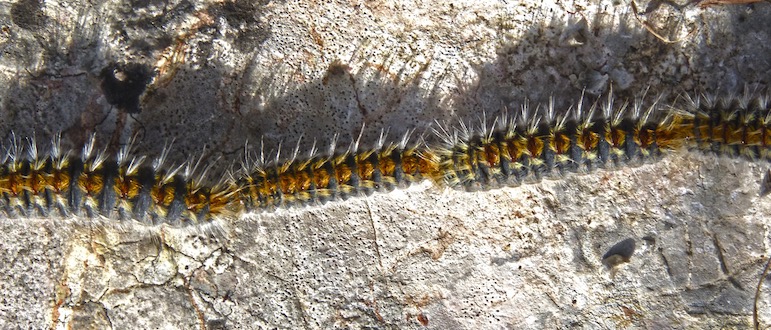
Tips and news
Pine processionary caterpillar: first aid guide for dogs
As the heat arrives, outings to rural and mountain areas become more appealing. However, there is a greater risk for us and our pets. In this post, we talk specifically about the processionary caterpillar and its stinging effects.
What is the pine processionary caterpillar?
Processionary caterpillars (Thaumetopoea pityocampa) are caterpillars covered with long hairs. When they feel threatened, they can throw their silky hairs into the air, generating irritations and allergies to people and animals.
The hairs of the processionary caterpillar have a toxin called thaomatopin that can cause extremely serious consequences, or even mortality. This is a veterinary emergency that cannot wait.
They are found in parks, rural areas and forests where there are pine and cedars. It is called processionary because when they break the pocket in which they nest, they descend to the ground forming a parade that slides like a procession to bury themselves. They usually walk on the ground in February, March and April. However, they can occur earlier due to the effects of climate change. In fact, the first processionaries have already been seen in Barcelona. During these dates, it is recommended to avoid areas where they can be found.
Risks to pets
When our pets come to sniff, the caterpillar throws its hairs in defense. The hairs, in turn, remain attached to the most unprotected areas of the skin: the mouth, the tongue, the nose, the eyes and the legs. The greatest risks are that the animal’s skin can necrotize and, if the infection reaches the larynx, it can cause death by suffocation.
How to know if your dog is affected?
The most common symptoms are nervousness, constant swallowing, pawing at the mouth, and excessive salivation. In a few minutes you could see inflammation and necrosis of the tongue.
First aid guide
To reduce the severity of the situation it is important to follow this first aid guide as soon as possible.
It is vitally important to remove those stinging hairs before taking your dog to the vet so that they stop doing damage as soon as possible. To inactivate the toxin you will need:
- Gloves preferably silicone
- Large amount of warm / hot water
- Physiological serum
- Vinegar or lemon
Put on gloves, even if you are not going to directly touch the insect, the hairs of the caterpillar can be transferred very easily.
We pour water under pressure at a warm / hot temperature, to destroy the toxin. In the event that the affected area is the mouth, it will be necessary to pour an abundant amount of water with a hose. To ensure that the toxin is destroyed, vinegar or lemon should be sprayed on the affected areas (which are usually the snout, tongue, lips, mouth and legs). In no case will the affected area be rubbed.
Since the hair of the caterpillar is volatile, we will put physiological saline in each eye to clean them, preferably 2 eye drop dispenser for each eye.
Dry the dog a little with a towel and take him to the emergency room quickly so that he can receive medication as soon as possible.
Better to be careful
You know, prevention is better than cure. Avoid areas of parks, rural areas and forests where there are pines and cedars in spring. And be very attentive to the ground, if you see a processionary better go elsewhere.
If, unfortunately, your dog comes in contact with the processionary’s hair, do not rub the area. Clean with soap and neutral soap, spray with vinegar or lemon and run to the vet.









